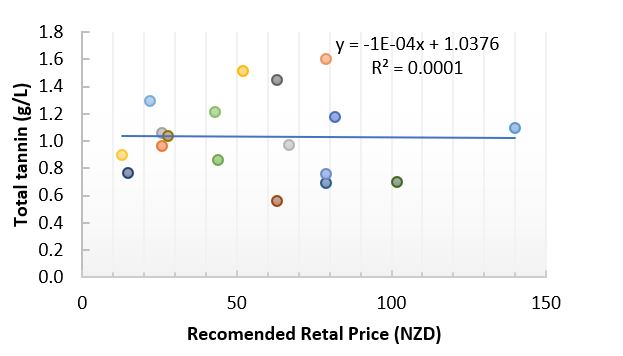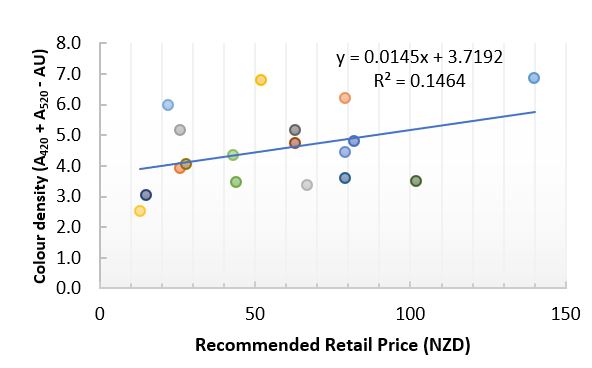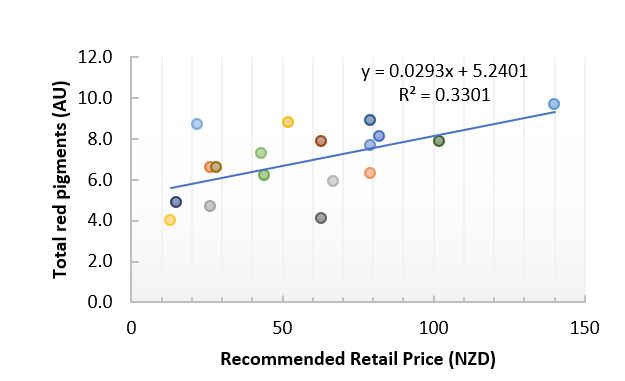Colour, phenolics and grading of Pinot noir wines
Leandro Dias Araujo, Paul Kilmartin
University of Auckland
Phenolic compounds, mainly free anthocyanins and pigmented tannins, are responsible for the colour of red wine. The colour hue and density are correlated to the concentration of these compounds. Many factors play a role in determining these levels, which are hugely variable between and within varietals. Condensed tannins are also responsible in large part for the mouthfeel of red wines, determining its astringent qualities.
The importance of appearance to the quality assessment of food products and beverages is well known. Consumers, and experienced professionals alike, often make assumptions about flavour, texture and overall quality based on expectations from previous experiences. Colour, among other visual descriptors, is a central factor in these expectations. Indeed, experiments have demonstrated how colour can influence the perception of flavours and its intensity and the perception of quality.
The value allocated by commercial wineries to their wines can be closely related to the concentration of phenolics and tannins, and also to the colour density of the wine, at least in regards to studies on Cabernet Sauvignon and Syrah. These studies examined the grade allocation and wine composition of a number of Australian wineries. The results can be extended to wineries around the globe producing bold, full-bodied Bordeaux-style wines, where the aim is to achieve high colour/tannin levels. On the other hand, the same argument might not be valid for wines produced from thin-skin, low-tannin, low-anthocyanins varieties such as Pinot noir.
We have recently analysed 18 New Zealand Pinot noir wines from five regions and from affordable to premium grades (NZD 13 – NZD140). We measured a series of colour parameters, total tannins, and total phenolics. This set of wine samples, with a more than 10-fold difference in price, had a nearly 3-fold difference in total tannin concentration, ranging from 0.56 to 1.6 g/L with an average of 1 g/L epicatechin equivalents, as measured by HPLC. As expected, these values lay within the concentration of tannin seen in the lower grade Cabernet Sauvignon and Syrah wines. Similarly, the colour density (0.6 to 1.6 AU) and total phenolics (31 to 68 AU) varied significantly among wines. The high variability in phenolic content of Pinot noir wines has been reported before, reaching a 32-fold difference in a much larger sample set.
Unlike the reports with Cabernet Sauvignon and Syrah, the total phenolic content and total tannin did not have a significant correlation with retail price (Figure 1). Due to the low tannin content of Pinot noir grapes, different maceration strategies are used to increase extraction and thus improve the colour intensity and stability and mouthfeel. These include the addition of foreign tannins, non-traditional maceration techniques (ACE, microwave, flash release, among others) and the inclusion of stems. This complicates the straight forward consideration of total tannin content as a predictor of price/quality, since not all of the tannins are from grape origin, and the tannin boost can not automatically be translated into a higher pigmented material.

Figure 1. Relationship between total tannin and retail price of NZ Pinot Noir wines.
The colour density and hue were also not significantly correlated to price (Figure 2). However, a trend started to form, with the most expensive wine having a particularly high colour density and the most affordable wines having the lowest values. The chemical age (ratio of total pigments to total phenols) and monomeric anthocyanins (calculated as total pigments minus non-bleachable pigments) were also significantly correlated with price.

Figure 2. Relationship between colour density and retail price of NZ Pinot Noir wines.
We can observe a clearer trend correlating the retail price with the total red pigments (Figure 3), which had a statistically significant correlation (p<0.05). The measurement of red pigments is done by acidifying the wine to pH<1 and measuring its absorbance at 520 nm. In contrast, the colour density is the measurement of the absorbance of the wine at 420 nm (brown) and 520 nm (red) at the original conditions. By acidifying the wine, we can assess the red pigments coming from anthocyanins and part of the pigmented polymeric tannins without interfering effects on the state of pigment equilibria. These effects can be pH, free SO2 level, and co-pigmentation factors which affect the colour density. In this way, the measurement of red pigments is more related to the content of pigments than to the colour of the wine.

Figure 3. Relationship between total red pigments and retail price of NZ Pinot Noir wines.
One observation from this relatively small set of Pinot noir wines is that the intermediary wines have a high variation in terms of phenolic content and colour so that it would be impractical to use these parameters in the decision making processes regarding commercial grading. In fact, researchers have demonstrated that colour was not a major factor in the quality assessment of Pinot noir wines by French and New Zealand wine professionals and that perceived balance was more significant. This expert notion on Pinot noir quality can also explain the lack of a strong correlation between the wine grade, here analysed as retail price, and the phenolic content and colour attributes. The consumer notion, on the other hand, could be different, especially among those less well-versed in wine and the particularity of each variety.
Understanding the chemical markers driving the quality perception of Pinot noir wines for both experts and consumers can provide a critical tool to viticulture and winemaking. The same set of parameters cannot be used indiscriminately for all varieties. Within the wider Pinot noir programme, we have aimed at establishing a comprehensive set of methods that will allow us to study in-depth the phenolic composition of Pinot noir grapes and wines. These methods, new to the New Zealand wine research scene, has recently been applied to these 18 wines, and comparisons will now be made with the outcomes of sensory studies made within the wider programme. This information will be used to better understand the role that phenolic compounds have in the sensory attributes of Pinot noir wines.
This article first appeared in the June/July 2020 issue of the New Zealand Winegrower Magazine.

















